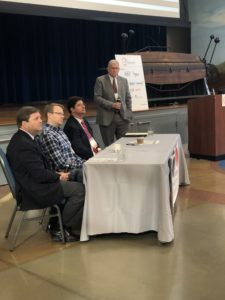This story is included in a multi-part series
ST. LOUIS, Mo. – Infrastructure, energy efficiency and economic development have been the striving focus for the Show-Me State.
In recent years, the Missouri Energy Initiative has been working with Missouri legislators to make sure that the state has a voice while also providing data-driven evidence.
“The Energy Initiative is made up of more than 30 different organizations from across the state looking to increase energy-related economic development through collaborative public-private partnerships, information [and] education,” Josh Campbell, executive director of Missouri Energy Initiative said. “Ultimately, working to have better pragmatic policies in the state through stakeholder engagement.”
Wednesday was MEI’s third component of their annual Midwest Energy Policy Series for the 2018 year.
Looking for a way to dive deeper into specific questions and topics, MEI used Wednesday’s event to take the time to answer and discuss those that had been selected as a priority by the MEI Board, who believed that the topics would impact the state or was of major concern and/or interest.
“We also prioritized the state energy plan,” Campbell said. “Based off our efforts, 2015 demonstrated economic benefit from states that have a state energy plan. The state has developed one, the Division of Energy is working on some components of it. We are working with several legislators, several of which who are here today, to introduce a state energy plan process, to make sure that stakeholders have a regular input and that it’s data-driven.”
Some of the questions and topics now, among others, are what is new; what is driving growth in the economy; how does the growth in the economy in the energy sector affect economic development, research and collaboration; how can the state be more competitive and how future technology is pushing today’s economy.

Jim Curran, executive vice president of Electrical Connection, Moderator and Electric Vehicles; Tim Arbeiter, director of Broadband State of Missouri; Tim Sylvester, CEO of Integrated Roadways and Tom McMahon, senior vice president of Advocacy and Government Relations, Association for Unmanned Vehicle Systems worked together to answer some of these questions.
“Can Missouri be competitive with other states on retaining, expanding and attracting economic development opportunities? In my judgment the answer is…yes,” Curran said. “We have talent, skilled resources based here in Missouri now. Not only to be competitive but to lead the way worldwide in new technology development, escalation and acceptance.”
Curran noted that Missouri Governor Mike Parson has announced that two of his top priorities for the state are workforce development and infrastructure.
“When it comes to the future of technology, Missouri is already rich with talent and can be a go-to resource to help us get from where we are today to be even better for tomorrow,” Curran said.
Arbeiter turned the topic of Broadband in a different direction and explained how today’s technology is driving the future economy.
“One of the core things that happened this past legislative cycle, and again there are several legislators in the room so the credit goes all to them in working with the governor’s office and the state agencies, but they really looked at Broadband acceleration of employment of public importance,” Arbeiter said. “This particular language resided in the rural electric cooperative bill.”
Arbeiter is referring to House Bill 1880 which was signed into law and became effective on August 28th and gave Broadband the tools they needed when looking at future opportunities. He noted that many states are ahead of Missouri, but Broadband is hoping to take advantage of the opportunities by working on the “bridging of the digital divide.”
“We know that this is not just a rural issue, but there is also struggles in suburban markets and urban markets,” Arbeiter said. “But we’re going to learn things along the way that may have great quality and benefit for our suburban and urban markets. It will be a comprehensive statewide claim…but our first and primary focus is rural Missouri.”
In addition to reaching the rural areas, Sylvester noted that the public right of way is key for next-generation technology.
“Over the next couple of years,” Sylvester said. “It’s going to be cheaper to build smart roads than it will be to build roads the way they are today.”
Currently, whenever developers want to add new technology, they have to go out to build again. However, developers can incorporate the technology at the beginning of the building process which will add enough capacity for the life of the road.
“We build one time,” Sylvester said. “The next time we want to add stuff, we just go out and plug it in…from a power-generation use standpoint this is a huge opportunity for our existing providers and labor forces to participate in this next generation of development.”
Along with charging vehicles, the world has seen a population in drones, unmanned systems. Amazon wants to start delivering packages, that weigh five pounds or less, to consumers in 30 minutes. Nearly 80 percent of packages that Amazon already delivers weigh less than five pounds, which is already setting them up to deliver items as quickly as they can and allows them to compete with other stores like BestBuy, Staples, Office Depot or the grocery store.
“There is great economic potential for drone delivery and for other types of usage for drones,” McMahon said. “They can be used in agriculture, they can be used in the cellular telephone business for doing inspections, they can be used for highway departments to do surveys of roads.”
McMahon said many research firms have worked to find different possibilities and usages that the Unmanned Aircraft System has the potential to do and have an impact on the nation’s economy and developing the workforce.
“While we have the technology to [deliver to people’s homes like an Amazon Drone video shows], we don’t have the policy in place to do that,” McMahon said. “Right now you can fly a drone under what the FFA calls the Small UAS Rule.”
Drones can only be flown during the day and as far as the line of vision for the person who is operating it. Drones cannot be flown higher than 400 feet or near aircraft or airports. McMahon said that there are many limitations when operating drones and licenses are required for those who want to fly for commercial purposes. However, a test is not required for recreational purposes, they just have to abide by the guidelines established by the Academy of Model Aeronautics.
McMahon also said things are changing in the industry with the FFA Reauthorization Act which was recently passed by Congress. He said that there are three components that are going to advance the Unmanned Aircraft Systems industry in the next several years, FFA Airspace Jurisdiction, Unmanned Traffic Management Systems and Authority to Mitigation, which will enable those involved to try more advanced operations such as package delivery.
“FFAs primary concern is how do we keep the airspace safe and that’s what we’re doing a very good job of,” McMahon said. “We have one of the safest airspaces in all of the world and by working with state and local governments these pilot programs will come up with rules for drones to ensure their safety and mitigation in the airspace.”

